Ethiopia
South Omo - the Hamer and Mursi Tribes - 26th June - 30th June 2011
Our first stop in Ethiopia was Turmi, home of the Hamer tribe whose bull jumping was made famous in the Bruce Parry's "Tribes" series. We didn't see any bull jumping but we did brave the local market. It was a quite amazing experience. We walked along the dusty road alongside the other market-goers. They were dressed in beads and skins and little else and were carrying their wares, mainly chat (a mildly narcotic chewing tobacco). Every so often one of the braver ones would whisper "photo, photo", meaning they wanted you to take their picture - for a fee of course.
The market place was crowded. Most people ignored us and went about their business but some, especially the young girls, were keen on being models and great experts at trying to wheedle more money out of you than you had agreed, pretending to be disgusted, insulted and generally kicking up a great fuss in the hope you'd pay them to go away. It was exhausting but fun.
The Hamer men all carry little head rests (a bit like tiny wig stands) to keep their hair out of the dust when they fancy a quick lie down. They almost look as though they are levitating, especially when they have thrown a cover over themselves. The women cover their skins and hair in a mix of red clay and fat.
It felt a little like being in a different century, if not on a different planet. I have no idea how much longer these people can remain so little impacted by the world.
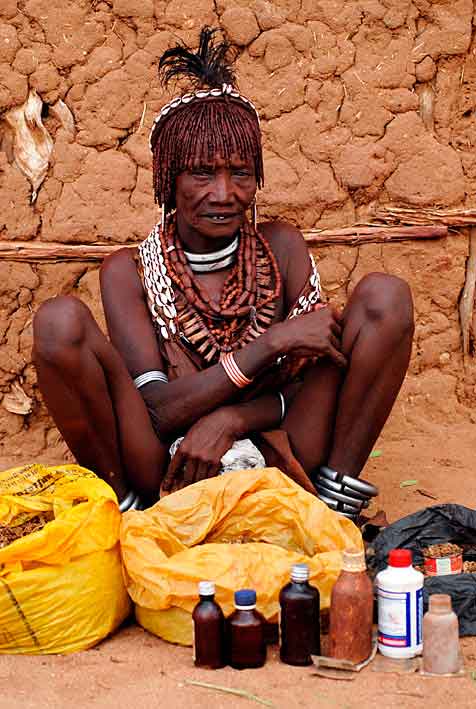 | 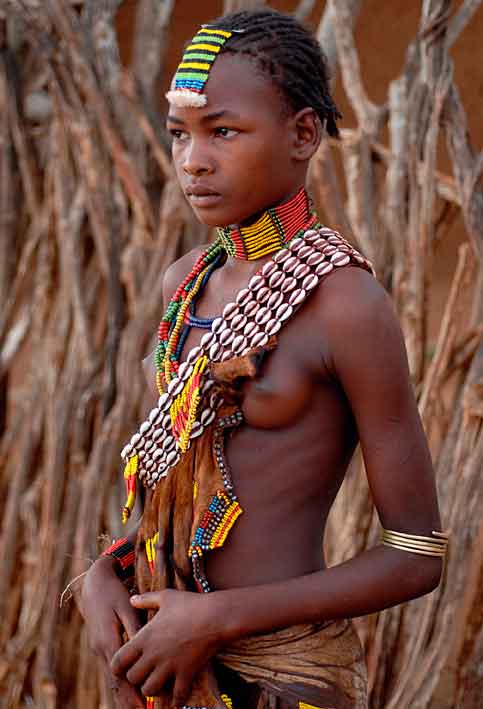 |
Back at the campsite Jerry got out his portable printer. A couple of the local kids were fascinated to see pictures of themselves appear and went away clutching their photos proudly. For that evening and the next morning there were a constant stream of people all wanting photos of themselves to take away.
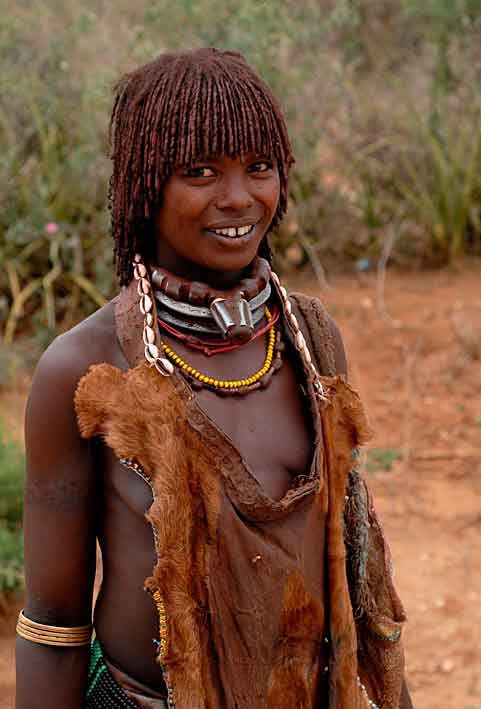 | 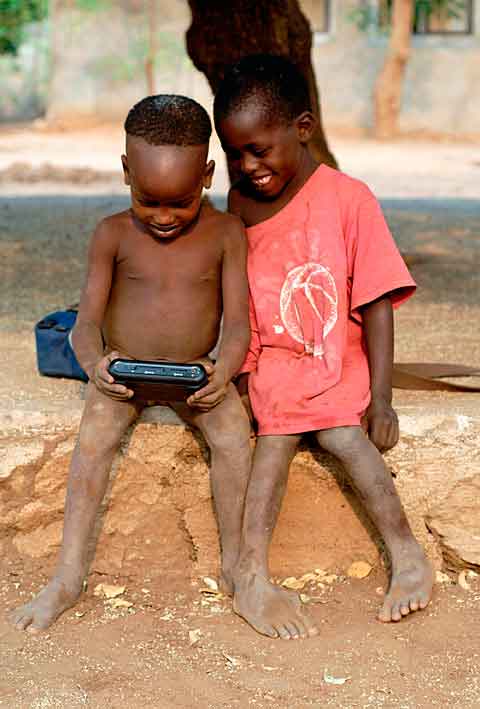 |
The Mursi are one of the best known tribes. Famous for their grotesque lip plates and body scarification as well as their volatile natures. They also live in an area which is difficult to get to. The night before we left for our visit it poured with rain and we debated whether to take the trip. We decided we'd give it a go and turn back if it looked too difficult. The road leads over some steep hills in an area famous for the dreaded black cotton soil - a deceptively slippery and sticky surface. The road, however, had clearly had a lot of maintenance and when we stopped for a break we laughed about our groundless concerns. Always a mistake. Just minutes later we set off down the hill with Dave and Naomi in front. Their Land Cruiser started to slide sideways and Dave had to struggle to keep in in a straight line (no fun when there are vertiginous drops). After that we crept down the slopes at a snail's pace.
At the bottom of the hill we picked up an armed guard as the Mursi are famously argumentative and have their own weaponry. The village visit was along the lines of a sustained and mostly non-violent mugging. Various bizarrely costumed and bedecked individuals gathered around, hanging on to us and demanding their photos taken. Each photo had to be individually negotiated with our guide as mediator. At the end of our photo shoot Jerry made the well-intentioned but, in retrospect, unwise, decision to print off some of the pictures he'd taken on our portable printer. Within moments the car was surrounded by people clamouring for prints, more photos and more prints. At last we managed to close the doors on them and make our escape but as Jerry pulled away from the crowd there was a general screaming and shrieking. We had run into a dog under the car (presumably hiding from the rabble). The dog ran off, a little muddy but seeming none the worse for his experience. However, the Mursi had seen a financial opportunity and were clamouring for compensation. Our guard who, having the biggest gun seemed also to get the last word, intervened on our behalf and we drove off with hearts in our mouths.
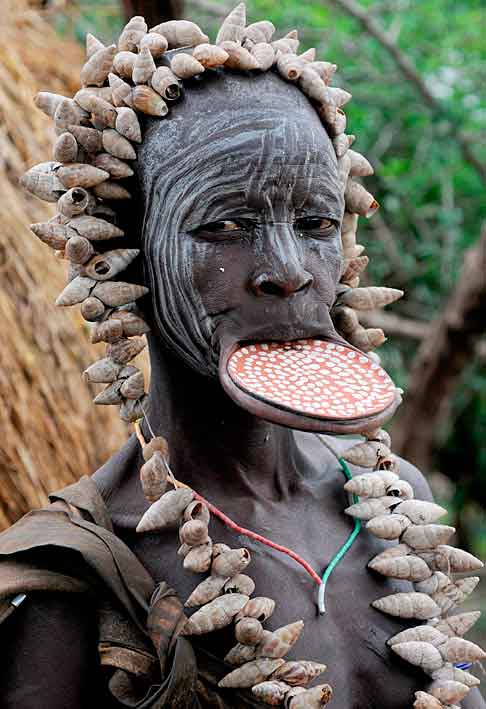 | 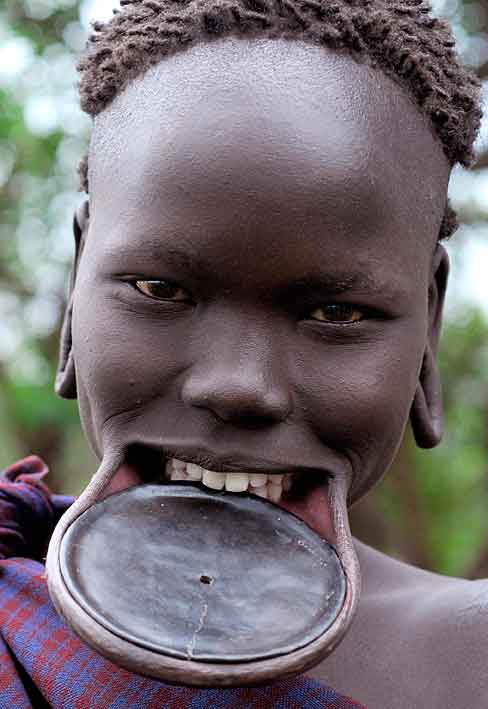 |
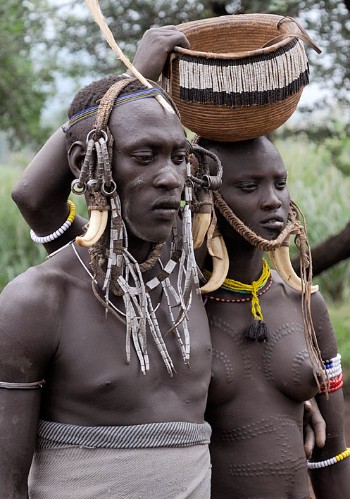 | 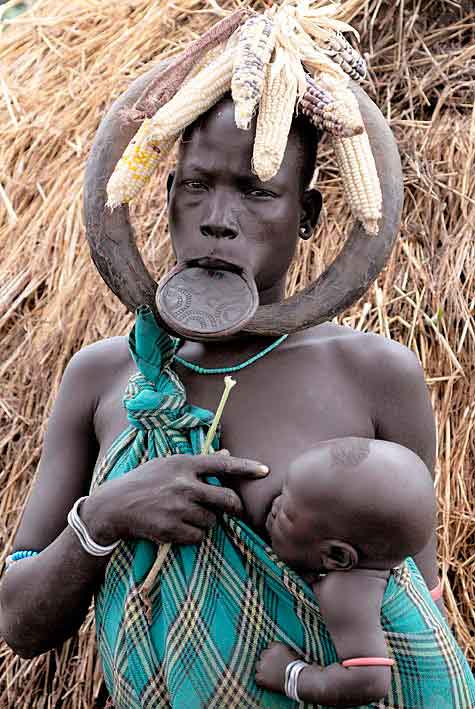 |
Arba Minch, Dorze and the Konso Tribes - 1st July - 3rd July 2011
From Jinka (our base for seeing the Mursi), we headed east to Arba Minch, the biggest town in the area. This is where the Konso tribes live and we spent a morning with a guide, Chuchu, visiting three villages. It was fascinating and we learnt a lot about their traditions and practices.
The first village we visited was known coloquially as "New York". It sits on the lip of a miniature Grand Canyon containing amazing towering structures of sand formed by water erosion. We said we wouldn't fancy a house on the edge but our guide was insistent that the ground was no longer moving...
A lot of the ritual surrounded marriage and death. For example, the men belong to a specific generation which
spans 18 years. Each 18 years a ceremony is held and all men aged 8 or
above are initiated into that generation and can marry. If a boy is
under 8 he must wait another 18 years and can "become a man" only at the
next ceremony. At each ceremony a huge generation pole made of juniper
is raised and you can tell from the number of poles how old each village
is - sometimes up to 500 years. In order to tell if a man is ready to
marry they have a huge round stone that he has to be able to lift over
his shoulder and drop behind him. Jerry was so adept at this he
immediately aquired two admiring wives though I think they may not have
been the pick of the bunch (see below).
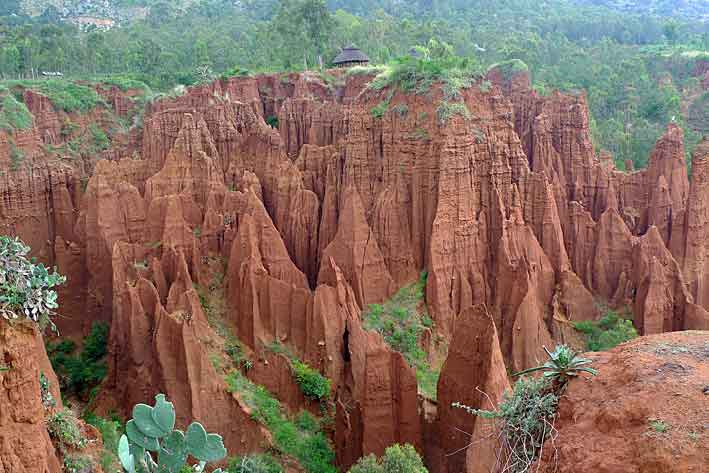 | 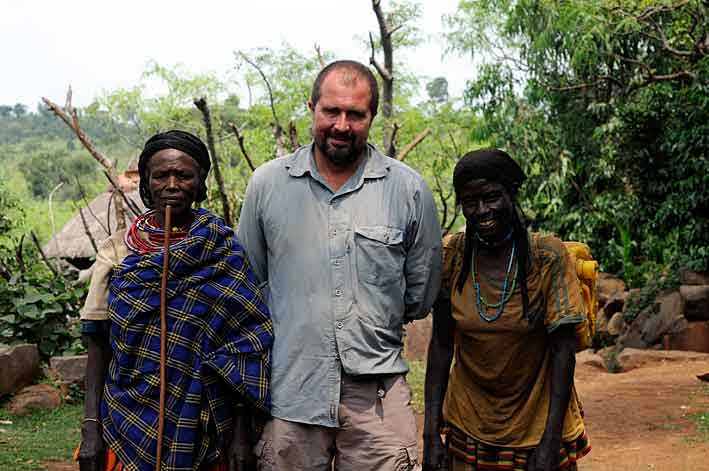 |
We also saw lots of "wagas" which are carved images of their dead that live in the courtyards of their huts and keep an eye on the younger generations.
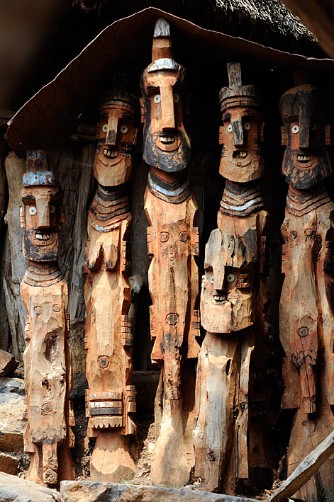 | 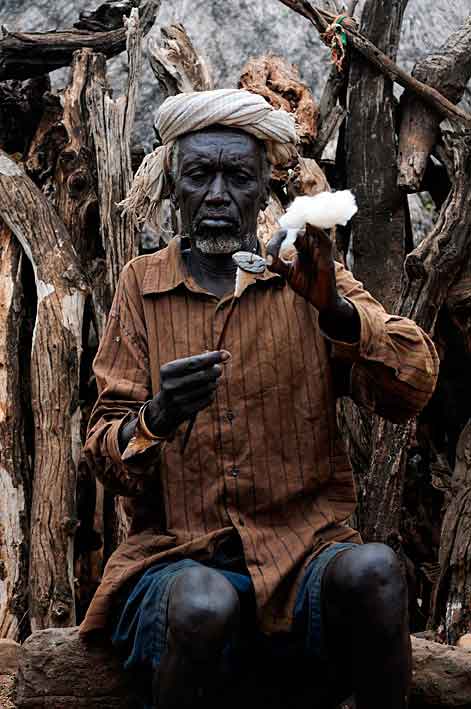 |
Arba Minch itself overlooks two enormous lakes; Abaya which is a pinkish red and Chamo which is a more traditional blue. We had our morning coffees/sundowners watching the sun set and rise over this glorious view.
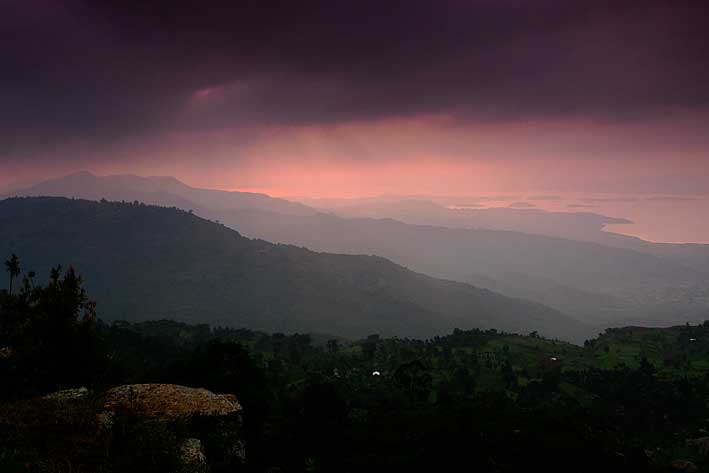
Our next visit was to the Dorze, a tribe famous for their weaving who live high up in hills. They build very distinctive, tall houses whose walls are woven from enset or false banana. The reason for their height is that the bases are eaten by termites so over the years they gradually reduce.
We had a great guide here, Tazira who showed us round the compound getting people to demonstrate cooking and weaving. We sampled the local bread made out of enset pulp fermented for several months and then baked over the fire wrapped in leaves. Amazingly very tasty. We also tried the local firewater which was almost undrinkable and the strongest chilli sauce I have ever sampled.
The next day there was going to be a wedding and the women of the village were busy preparing food. They were in the process of cooking over a thousand injera (the local spongy flat bread). Unfortunately the bachelor party, who were in boisterous spirits, were polishing them off as soon as they came off the fire.
At one point on our visit we met a couple of old women keen to demonstrate smoking through a kind of hookah. One was a little scary and when Tazire had a few sharp words with her she spat at both me and him. Quick as a flash he said "sign of respect'. Sure, I thought, but you have to admire his presence of mind!
For the next couple of nights we stayed in our very own Dorze house at Dorze Lodge, the views were spectacular, the manager very friendly and it was a welcome rest after a couple of hectic weeks.
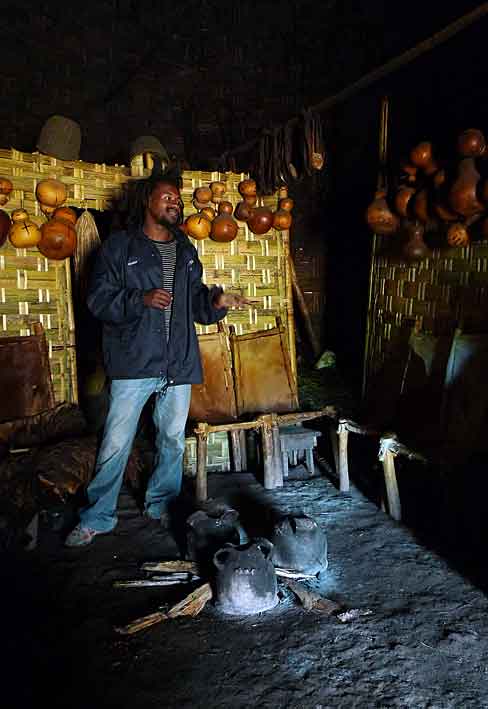 | 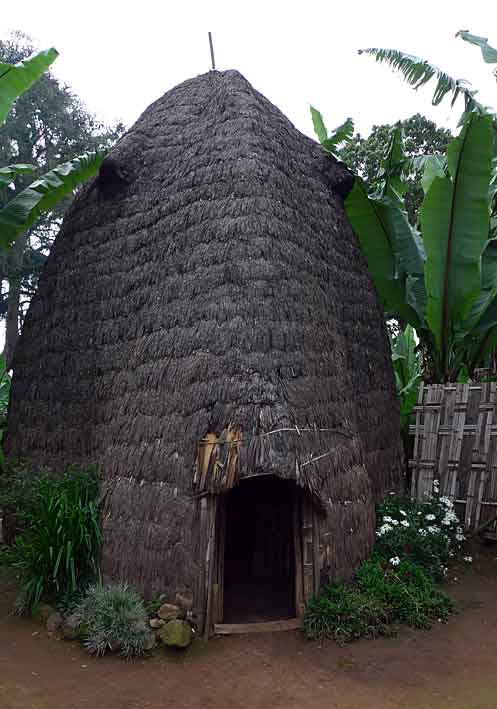 |
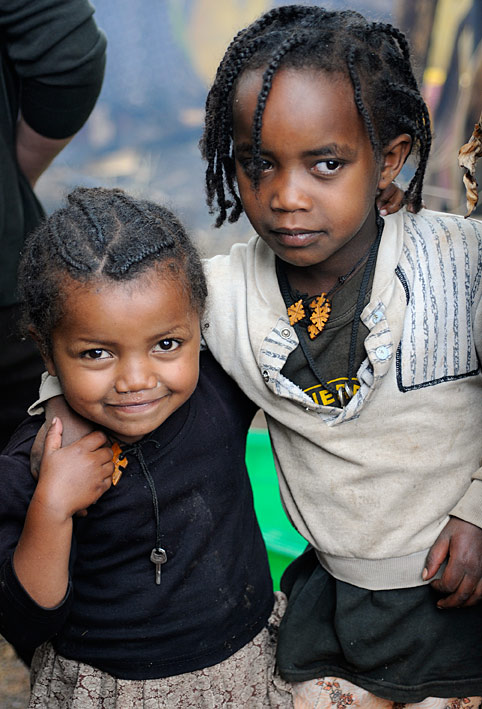 | 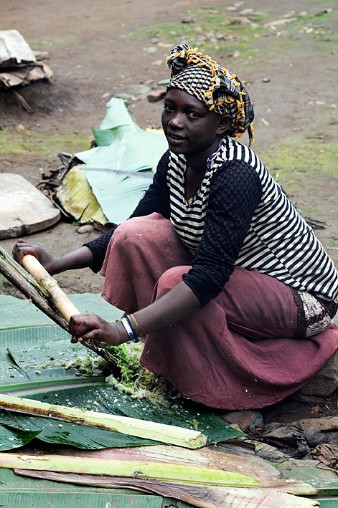 |
Awassa - 4th July - 7th July 2011
Arba Minch to Awassa didn't have much to recommend it as a route in the guide books but there was lots to see along the way. No sooner had we finished laughing about the boy riding his donkey cart (a square wooden platform on wheels) like a chariot out of Ben Hur than the next one went by with the boy prone on the planks seemingly fast asleep. There seemed to be lots of graduation ceremonies taking place and we saw students bedecked in all their finery, one older girl with meticulously curled hair struggling to walk on her stilettos with straps up to mid calf, another, perhaps only 6 or 7 years old was resplendent in her gown and mortar board but more interested in how big she could get her bubble gum bubble.
Having moved in and out of the Rift Valley several times in recent weeks we are used to some fabulous views and steep descents but this one was the most dramatic. The ground was so far below it was scarcely visible through the haze. We reached the top, pointed the car's nose downwards and crept down the hairpins.
Awassa was only really a stopover for us, being halfway between Arba Minch and Addis. However, we were seduced by the idea of free wi-fi and DSTV for $20 a night and the one night stretched to three.
Addis Adaba - 7th July - 11th July 2011
Our
main reason for coming to Addis was to extend our visas. You can only get visas
for Ethiopia from your home country which posed a problem for us. We had
managed, with some persuasion, to procure 6 month visas when we were home for
Christmas and entered Ethiopia with only 10 days left on them.
We had been warned about Ethiopian red tape and it lived up to our lowest
expectations. Getting extensions involved the best part of a day with
taking slips of paper from one room to another. Plus an
"interview" with a rather stern official. Still we got a 30
days extension.
We based ourselves at Wim's Holland House in Addis - a long standing
overlanders' hangout and it was great to be able to swap information and
stories with travelers going in the opposite direction. We also managed to
sample a few of Addis's excellent and very cheap restaurants.
Harar - 12th July - 16th July 2011
We set off towards Harar with Lu and Guy, an English couple we'd met at Wim's. Unfortunately after 100km or so they noticed a problem with the car and had to turn around. We carried on to Awash, our overnight stop. We were much lower than in Addis and the air was hot. The scenery was dramatic and we passed a semi active volcano (apparently you can sometimes see fireworks at night!) and black lava flows before crossing a causeway bridging a lake at the foot of the volcano. We stayed at the top spot in town the Haile Sellassie Suite at the Hotel Buffet - for the princely sum of 5 pounds.
The next day we pulled into Harar. Harar is an ancient walled city, predominantly muslim. The streets of the old town are steep and cobbled. We had arranged to stay in a traditional Harari stone house built around a court yard.
The following morning we met up with Lu and Guy (who had hopped on a coach the day before) and our guide Abdul for a tour of the city. Abdul took us through the markets and up and down the winding streets visiting shrines, mosques and coffee makers. The markets were fascinating, everything and anything was for sale from Arsenal underpants to frankincense and myhrr.
That evening we went to the hyena feeding that Harar is famous for. No-one is quite sure how this started, probably as some kind of charm against drought and famine but now an individual man feeds the local hyenas every night inviting visitors to participate. You put meat on a stick and the hyenas gently take it off. Having seen these animals ripping carcasses apart in the wild I wasn't sure I wanted to hold out my hand anywhere near one but they were incredibly subservient. It was quite an experience.
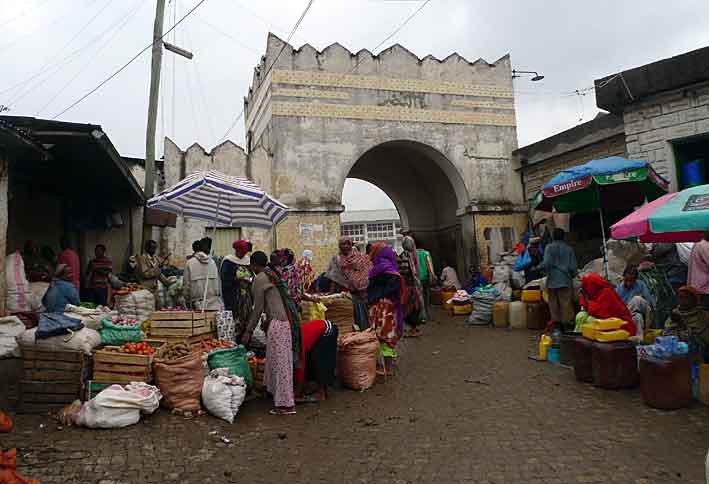 | 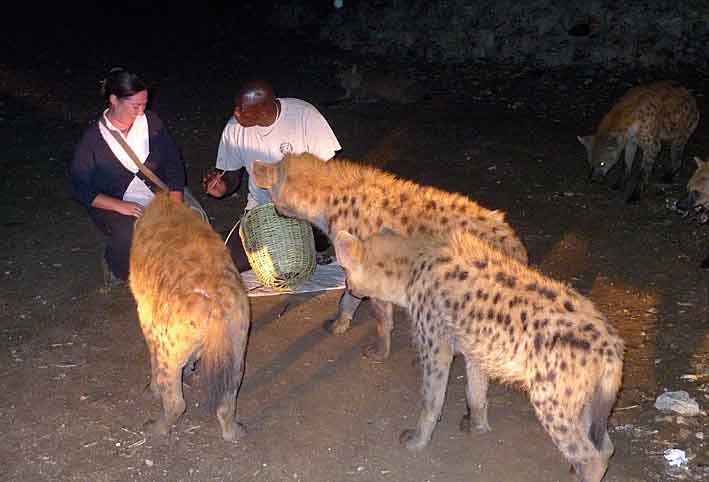 |
Addis Adaba - 17th July - 20th July 2011
It
was back to Addis to try and sort a few final things on and catch up with our
friends at Wim's Holland House.
Lalibela - 21st July - 23rd July 2011
Lalibela is probably the most famous destination in Ethiopia. This tiny hill-top town is the site of some incredible rock-hewn churches. These enormous monoliths and partial monoliths have been chiseled by hand out of the rock from the top down with the result that they are now set in deep trenches.
Experts believe they date from the 12th century and that it probably took 40,000 people to carve them (even supporting the burgeoning tourist industry, Lalibela only has 20,000 souls today). They are as much of an enigma and a mystery as the pyramids are.
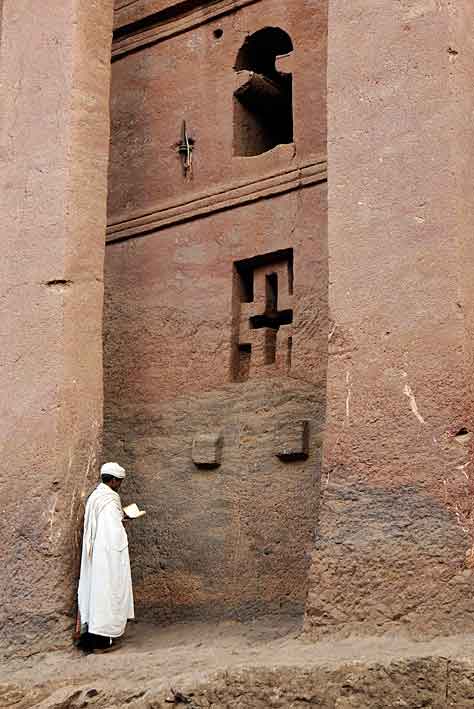 |  |
However, unlike the pyramids, the churches are still in active use we
watched hundreds of pilgrims, all wearing white shawls making their way in and
out of the different churches. The air was filled with the sound of chanting
and the smell of incense. On Sunday morning we got up at 6am and listened
to a mass in Bet Giyorgis, a truly memorable experience.
Less spiritual but no less interesting was the weekly market which deals
in handmade rope, shoemakers making shoes to measure from old tyres and lots of
livestock as well as the local honey and woven cloth.
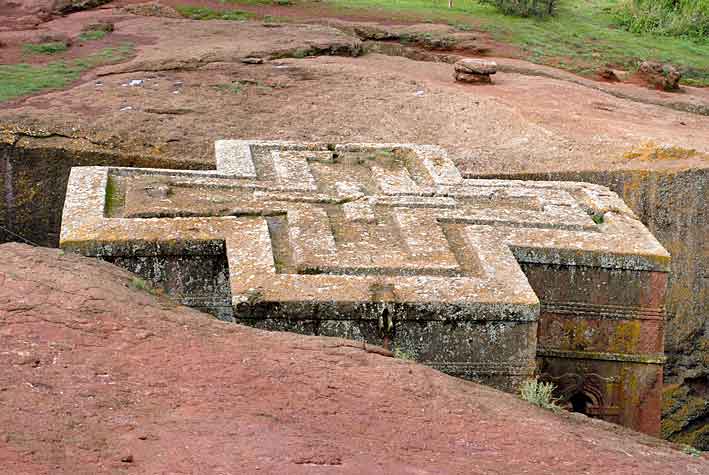 | 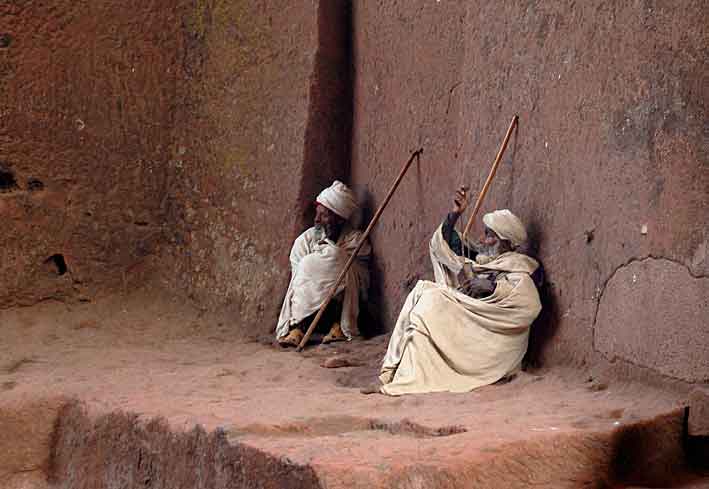 |
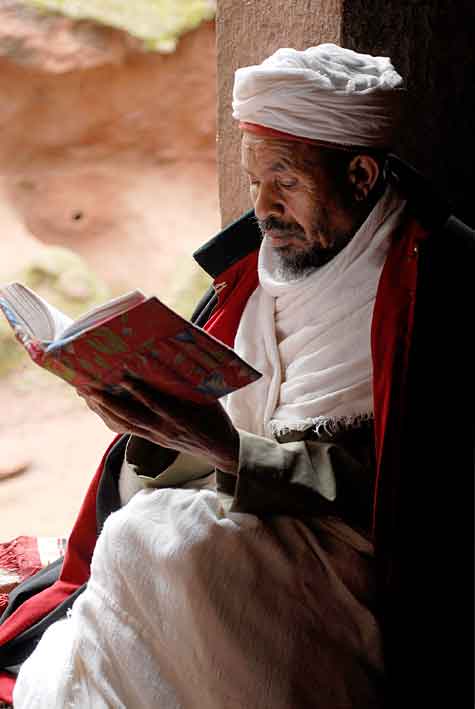 | 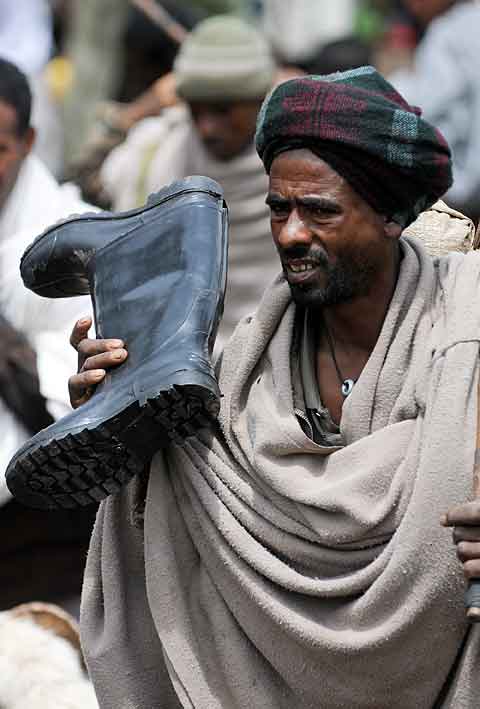 |
Mekele to Gheralta - 24th July - 28th July 2011
We headed north from Lalibela on a little used dirt road. We figured though it may take longer at least we wouldn't be stuck behind huge trucks belching black fumes. It was a good decision. The road was spectacular, winding over passes and past incredible scenery all the way.
We saw our first indication of the drought impacting the Horn of Africa. This area was the epicenter of the terrible droughts in the 1980's and - though we didn't see anything like the images we all remember from that time we did pass a big crowd where US aid in the form of big sacks of wheat was being distributed.
That evening we pulled up in Mekele - one of the biggest towns in Ethiopia - for the night.
The next day we set out for the Gheralta region, an area famous for it's rock-hewn churches. Unlike the Lalibela churches these are often positioned precariously up in the mountains - sometimes even carved into the cliff faces. If anything they are more amazing than their Lalibelan counterparts, most of them having been scraped out of the rock in the 4th century. They are still used as places of worship to this day. The highlights were probably Debre Maryam - a stiff climb up a natural funnel in the rock face and Abre et Abraham a beautiful church conveniently along the roadside. Here we were lucky enough to see a baptism - lots of incense and chanting. And unlucky enough to have the flags on our car peeled off by the local kids.
We stayed at the fabulous Gheralta Lodge - an Italian built lodge consisting of replica Tigrain roundhouses - complete with grass growing on the roofs for insulation. Dinner consisted of 5 (!) delicious courses and after some frankly ropey food in other bits of Ethiopia was a huge treat.
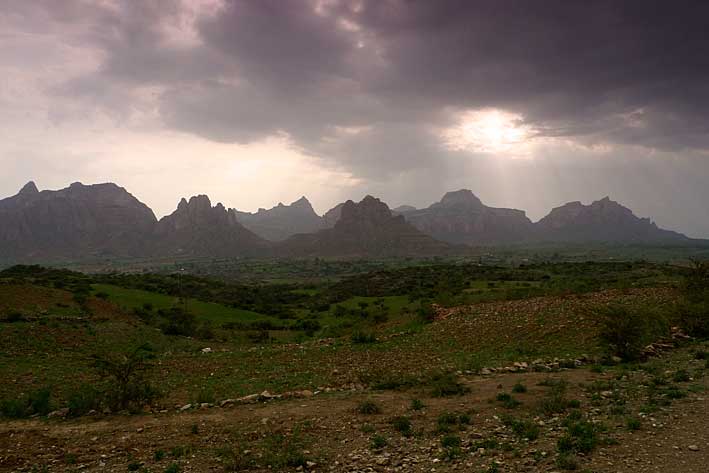 | 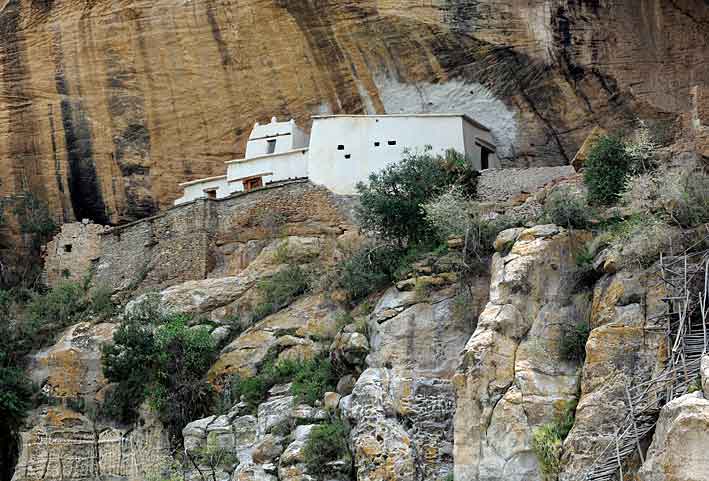 |
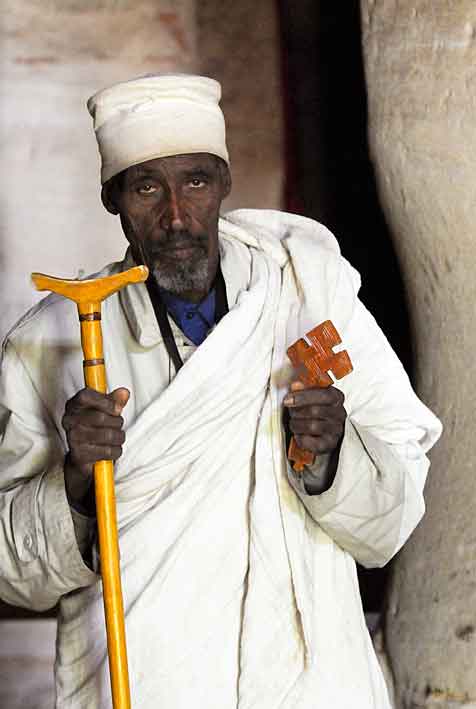 | 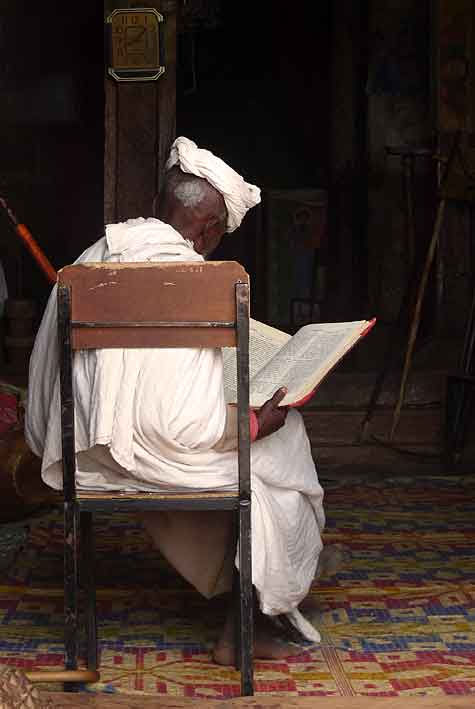 |
Axum to Debark - 29th July - 31st July 2011
It was sad to leave the Gheralta - it was an amazingly beautiful place but we had already spent two days longer than planned and had to push on. We took another "back road" to Axum. More deserted roads and amazing scenery.
Axum is now a rather grimy little town but has an astonishing history. It was the centre of civilisation in Ethiopia for some seven centuries from before the birth of Christ and was the place that the unique form of Christianity still central to the lives of most Ethiopians was born back in the first century. It is famous for it's archeological sites, ancient tombs and towering stelae (obelisks 30+metres high and carved out of single stones that no-one has any clue how they transported). The biggest stelae lies in pieces on the ground having apparently fallen during or perhaps just after it's erection. We felt for the guy in charge.
Maybe even more astonishing is the fact that these sites are all nestled in the middle of a bustling town. My favourite was a tablet of stone that three farmers found in their field. It dates back to the fourth century and was carved on the orders of the king of the day thanking God for his recent territorial conquests. It is in three languages - one local and two "international". It also contains a warning that it should never be moved. So it still sits in the field - albeit with a small brick-built shelter surrounding it and one of the proud farmers shows it off to visitors. It is also possibly the smallest and simplest Unesco World Heritage site in existence.
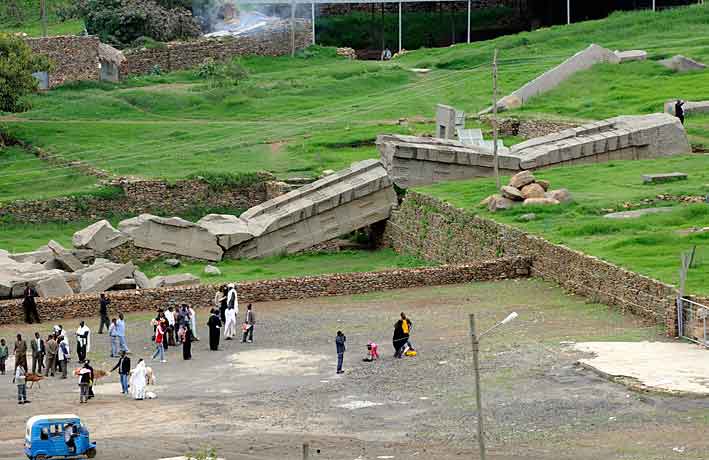
The drive from Axum to Debark was the toughest so far in Ethiopia. The dirt road is steep and winding ... and in the course of being rebuilt. There had been heavy rain in the last few days and some stretches were just steep, muddy gloop. It didn't help that we lost 4WD along the way (we, along with all the other traffic -two buses and a lorry, had to be towed up one particularly tough stretch by a grader!). And it certainly didn't help when a kid launched a rock through the rear window. This is an occupational hazard of traveling in Ethiopia. The roads are lined with shepherd boys and girls with rocks in their hands to control each goat/sheep/cow that starts to wander off and cars are tempting targets in an otherwise hugely boring existence. We had had a few misses but this one scored a direct hit.
Gonder - 1st August - 5th August 2011
We arrived in Gonder rather battered and feeling somewhat jaded with all things Ethiopian. Jerry's search (in the pouring rain) for a replacement drive flange and or window glass proved fruitless and he ended up struggling back with some pallets to try and put together a makeshift board to cover our broken window. We have decided a change of scene was in order - next stop Sudan!